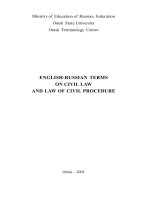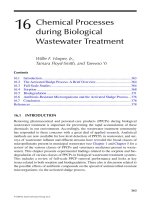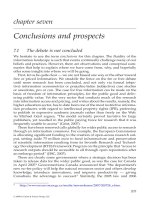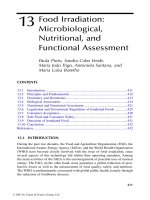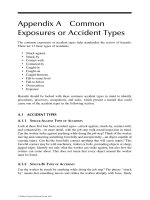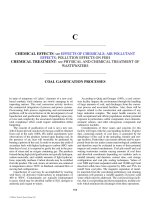Coastal Pollution: Effects on Living Resources and Humans - Chapter 15 (end) pptx
Bạn đang xem bản rút gọn của tài liệu. Xem và tải ngay bản đầy đủ của tài liệu tại đây (353.86 KB, 9 trang )
261
15
Summary and
Conclusions
It seems so long ago that we began the review of coastal pollution sketched briefly
in these pages. This, the last chapter, should logically be a summing up of infor-
mation covered and (for the author) the growing realization that so little of the total
story has been included. Every chapter could be and should be of book length.
Because this is not likely, an alternative might be to attempt the reverse — a
précis
of the topics covered to see if the distillation process releases additional juices of
insight and wisdom.
I feel at this point that some chapters are strong and others not so strong. I
particularly like the long chapters on quantitative effects of coastal pollution on fish,
on effects of alien species, on effects of coastal pollution on public health, and on
sublethal effects of pollutants on fish — but these pets are probably just reflections
of my own research interests. I am less pleased with the chapters on effects of
environmental exposures of humans to pollutants and on economic effects of coastal
pollution, but it is too late and I am too tired now to begin patching. What you see
is what you get.
However, in this concluding chapter I do want to revisit, fleetingly, most of
the principal topics covered in the chapters and in rough order of their appearance
in the book.
The introductory chapter considered the
health of coastal waters
with the general
finding that progress has been made, but environmental problems still exist, espe-
cially in enclosed or semienclosed seas and in estuaries with restricted exchanges.
The toxic waste disposal problem has been addressed and is being addressed in
western industrialized nations, but it is still acute in former communist bloc eastern
European countries and in developing countries.
Cholera
is still a global threat, but significant advances have been made in
understanding the ecology and genetics of the disease agent and of vibrio bacteria
as a group. Relationships of epidemics with coastal environmental cycles have been
elucidated, but universal access to uncontaminated water is an elusive goal and a
major impediment to reducing effects of this ancient pestilence.
Minamata disease
was an important consciousness-raising episode in the history
of human industrial development, and its effects can be seen in today’s society as
extreme public sensitivity and reactivity to reports of metal contamination of food
and water (mercury, lead, and arsenic would be good examples). Even today, there
is little that can be done to atone for the absolute horrors of that experience for the
Japanese — except for commitment to increased vigilance and improvement of
industrial practices.
9677_book.fm Page 261 Monday, November 14, 2005 9:17 AM
© 2006 by Taylor & Francis Group, LLC
262
Coastal Pollution: Effects on Living Resources and Humans
Research and publicity about potential damage to humans and their offspring
caused by the global presence of
PCBs and chlorinated pesticides
have helped to
raise public awareness, particularly about contaminants in seafood. Furthermore,
public suspicions have been raised about any new industrial chemicals, including
pharmaceuticals, that may enter environments and food.
Pollution of coastal
recreational waters
is a continuing public health threat as
more and more humans cro
wd into shoreline areas. Investment by governments in
improved sewage treatment facilities has not moved rapidly enough to do any more
than maintain a fragile status quo; public use of urban beaches is still a high-risk
activity, even though most (but not all) of the human health dangers are less severe
than they were early in the past century.
Harmful algal blooms
ha
ve increased in frequency, extent, and toxicity in recent
decades, undoubtedly due in part to organic loading of coastal/estuarine waters from
human sources (farm and other industrial runoff, sewage treatment plant effluents,
and so forth). Some of the algal toxins can cause serious human illnesses, and blooms
— toxic or not — create h
ypoxic/anoxic zones that can be lethal to marine animals.
Anoxia
, especially in estuaries and seas with limited water exchanges, is an
increasing problem related to eutrophication from organic loading. Anoxic zones,
such as those in Chesapeake Bay, Long Island Sound, and the Louisiana coast,
appear to be expanding, with consequent reduction in fish and shellfish habitats in
affected areas.
Petroleum
in quantity in coastal waters — from the many minor and the few
major oil spills — creates severe local economic problems and local environmental
impacts (most, but not all of which, are transient). Media attention is usually confined
to the major events. That attention has resulted in a substantial flow of government
and industry research that has provided good, but not complete, understanding of
environmental and resource animal interactions with oil. The number of major events
(involving pollution in excess of 10
7
gal of oil) is surprisingly small, considering
the amount of oil transported daily throughout the world. Improved tanker design
(double hulls) has undoubtedly helped to keep the number low.
Introductions of alien marine species
— deliberate or accidental — have
occurred throughout recent human history, but the pace has increased since World
War II, with more and faster ships in a worldwide network and with the phenomenal
expansion of marine aquaculture. The introduced organisms may live and die without
reproducing, or they may produce offspring but not dominate any habitat, or they
may multiply to a point where they become a dominant part of the flora or fauna.
The aliens (and their progeny) may produce drastic changes in ecosystems, they
may interbreed with indigenous species, or they may carry pathogens that infect and
kill members of the indigenous species. The aliens may become economically
important in aquaculture (oysters, salmon), or they may become unwanted predators
(green crabs, oyster drills) on wild resource species.
Coastal/estuarine fish can be subject to localized mass mortalities caused by
extremely high levels of pollutants (near industrial chemical spills or industrial
effluent discharges), but much of the damage to individual fish is caused by exposure
to
sublethal levels of chemical pollutants
. Effects can be especially severe on
embryos, larvae, and early juveniles of species that use coastal/estuarine waters as
9677_book.fm Page 262 Monday, November 14, 2005 9:17 AM
© 2006 by Taylor & Francis Group, LLC
Summary and Conclusions
263
spawning and nursery areas. Effects on early development may be morphological
or physiological, and they often result in later mortality. Pollutants such as PCBs
and chlorinated pesticides may be present in the tissues of adult fish and may be
transferred to eggs of females, causing developmental abnormalities and early death
of offspring.
After reviewing the many ways that pollutants may cause sublethal impacts on
individual fish, it is logical to ask
whether
pollution affects abundance
of
coastal/estuarine commercial fish species. The answer to that question is not satis-
fying. It is possible to identify quantitative effects of severe pollution on local
populations of fish and shellfish, but pollution has not been demonstrated conclu-
sively to cause significantly reduced abundance of an entire species. Too many other
factors, such as overfishing, predation, starvation, or abnormal environmental con-
ditions, can exert major influences on abundance, so it is difficult to isolate and
quantify the effects of pollution, even if those effects are occurring. Intuitively, we
would expect that the impacts of contaminants that have been demonstrated exper-
imentally in individual fish should be translated ultimately into population effects,
but this is difficult to prove in wild stocks of fish.
Whenever
marine mammals
— dolphins, whales, seals, sea lions, and their
relatives — die in large numbers (or even in small numbers), a likely suspect is
almost always coastal pollution. Many of us feel some affinity for these evolutionary
“kissing cousins.” We are concerned that the coastal pollution for which we are
responsible may be involved in their demise, and we must be sensitive to the
observation that mass deaths have become more frequent during the past 3 decades.
From information that is available, coastal pollution may be a culprit, but other
players are in the game, too. Many investigations have concluded that a wave of
mortalities of dolphins and seals in Europe and North America beginning in the
mid-1980s was caused by viral diseases, possibly abetted by reduced disease resis-
tance and physiological debilitation as consequences of pollution. A few other
mortality events — ancient and recent — were possibly caused by algal toxins
present in forage fish eaten by the mammals. No mass mortalities of marine mammals
have been attributed directly and exclusively to coastal pollution, to my knowledge
(with the exception of animals engulfed in spilled oil).
Although effects of pollution on fish and marine mammals are interesting sub-
jects of research and make good occasional headlines for the news media, it is the
public health
aspect of coastal pollution that properly gets most of the respect and
attention. Microbial pathogens in shellfish, toxic chemicals (mercury, PCBs, algal
toxins) in fish and shellfish, and disease agents lurking in the surf of bathing beaches
all contribute to massive regulatory problems and cause illnesses in humans.
Undoubtedly the largest public health problem associated with coastal pollution is
microbial contamination of molluscan shellfish
, which are still, in the 21st century,
consumed raw and quivering by hordes of stupid humans and which carry a panoply
of viral and bacterial pathogens. Coming in as a poor second is
chemical contami-
nation
of fish and shellfish
— shellfish that are grown in polluted waters or large
predatory fish that feed on contaminated animals lower in food chains.
Economic losses
due to coastal pollution have been examined in detail by every
coastal state and are always found to be substantial. Such losses may result from
9677_book.fm Page 263 Monday, November 14, 2005 9:17 AM
© 2006 by Taylor & Francis Group, LLC
264
Coastal Pollution: Effects on Living Resources and Humans
reduced catches and sales of seafood, loss of revenue from recreational fishing, or
reduced use of recreational beaches. Indirect costs (decreases in transportation of
products, sale of equipment, user fees, and travel and accommodations) have been
calculated for most coastal states, especially those with large commitments to exploi-
tation of coastal/estuarine resources. Published analyses of problem areas related to
pollution usually lead to increased regulatory activity and grudging improvements
to se
wage treatment facilities — all aimed at the most visible effects of urbanization
of the coastal zone.
Although not amenable to precise quantification, the effects of coastal/estuarine
pollution are important factors in
degrading the quality of life
of every person who
lives at or near the edges of the oceans and of many who live inland as well. Some
of the nation’
s coastal waters and harbors (Boston Harbor, the New York Bight,
Biscayne Bay, San Francisco Bay, and Puget Sound, to name only a few) have been
abused in the past by industrial effluents, ocean dumping, contamination from ships,
dredge spoil deposition, and a host of other degrading practices. Enforcement of old
and ne
w regulations has caused the discontinuation of many evil activities (such as
sludge dumping in the waters only 12 mi from New York City). So a new ethic has
developed — one emphasizing care of coastal/estuarine waters as a priceless asset,
replacing the previous ethic that condoned using the ocean and its watery margins
as dumping grounds for society’s wastes.
These
précis
or summary statements may have some utility as very brief remind-
ers of the book’s contents, but they lack the stature of good generalizations about
effects of coastal pollution. I have tried another approach to a graceful exit — a list
of principal conclusions about effects of pollution on marine organisms, ecosystems,
and humans:
First,
the technical literature is replete with examples of effects of pollutants
on individual fish and shellfish or on local populations, but no specific evidence
exists to indicate widespread damage to major fishery resources that can be attrib-
uted directly to pollution.
Other factors, such as repeated year-class successes or
failures, shifts in geographic distribution of fish populations, or overfishing, may
cause pronounced changes in fisheries — changes that could obscure any effects
of habitat degradation.
Additionally, the magnitude of fluctuations in fish population abundance, due to
incompletely known natural environmental causes, makes it extremely difficult to
isolate, quantify, and demonstrate the possible role of environmental
contaminants
in causing such fluctuations.
It may be, of course, that coastal pollution
is
exerting some overall influence on
certain resource species, but that this may be masked by increased fishing effort or
by favorable changes in other environmental factors that create a positive effect on
abundance outweighing any negative effects of pollutants. Many experimental stud-
ies, particularly those concerned with long-term exposures of fish and shellfish to
low levels of contaminants, suggest that some long-term quantitative effects should
be felt, but that our statistics, our monitoring, and our population assessments are
not adequate to detect them.
It may also be that present levels of contaminants in coastal environments are
not high enough to exert significant or observable impacts on fish populations except
9677_book.fm Page 264 Monday, November 14, 2005 9:17 AM
© 2006 by Taylor & Francis Group, LLC
Summary and Conclusions
265
in extremely localized, grossly degraded habitats. Local reductions in abundance
could easily be masked in large, often migratory populations that are being influenced
simultaneously by a host of natural environmental factors such as predation, tem-
perature, ocean currents, and food availability.
One additional reason that the effects of pollutants on marine resource species are
not easy to demonstrate may be the resiliency of estuarine and coastal populations and
ecosystems. Human activities (other than overfishing) may not have damaged entire
species enough to show significant effects — even though local populations may have
been reduced or eliminated, even though eggs and larvae may have been killed, and
even though forage organisms may have been affected. Counterbalances acting for the
species or the ecosystem, such as the great reproductive potential (fecundity) of most
marine species, the great species diversity in most ecosystems, and the adaptive
capabilities of many coastal-estuarine species to drastic changes in their physical-chem-
ical environment; all may offset the negative influence of pollutants.
Second,
proof of biological damage to resource populations caused by pollutants
is very difficult to acquire in the midst of many other factors that influence the
abundance of coastal species
. Effects may be long term, with average annual incre-
ments so small as to escape detection. Experimental information, particularly from
long-term chronic exposures to contaminants, suggests that some deleterious effects
can be expected and that they are probably occurring, but they escape our methods
of detection. Other evidence suggests that natural phenomena are still overriding
influences in the survival of coastal populations, but that the dynamic and precarious
equilibrium that permits survival may be overturned or distorted by human interfer-
ence. Still other evidence indicates that overexploitation of resource populations is
of overriding importance.
Third,
investigations of effects of chemical contaminants on resource species
have produced much useful information, including the following
:
• Contaminant levels in tissues of fish have been examined in a number of
geographic areas. In many instances, the widespread occurrence of detect-
able levels of selected contaminants has been demonstrated (PCBs, DDT,
mercury, petroleum components).
• Environmental contaminant levels in certain restricted coastal/estuarine
areas are sufficiently high to produce the acute or chronic effects seen in
experimental systems.
• In certain localized areas, tissue levels of contaminants have been recog-
nized in fish that are well above the few legal action levels that exist.
Toxic effects on the fish at such levels are largely unknown, as are toxic
effects of exposure prior to the buildup of measurable tissue levels.
Beyond this, the relationship between toxicity and any tissue level has
been inadequately explored. High body burdens of contaminants may be
sequestered and not affect health until a level is reached where accom-
modation is no longer feasible and spillover may occur.
• Inadequate data are available about the synergistic
effects on fish of
extremely complex mixtures of contaminant chemicals and dissolved or
particulate organics in polluted waters, but enough experimental data exist
9677_book.fm Page 265 Monday, November 14, 2005 9:17 AM
© 2006 by Taylor & Francis Group, LLC
266
Coastal Pollution: Effects on Living Resources and Humans
to state that antagonisms and synergisms in complex mixtures of contam-
inant chemicals may be important factors in producing any net effect.
• A much broader perspective focuses on cumulative
effects, which include
chemical synergisms, as well as interactions among fisheries, physical
degradation, and chemical contamination. It is possible to consider each
item separately, but in the end it is the totality of effects that is significant.
As an e
xample, fish do not encounter just dioxin or mercury but a whole
range of contaminants, and they can do so within highly degraded envi-
ronments. Most fish are highly mobile and tend to go from one estuary
or coastal area to another. Temporal effects may become apparent when
fish visit a highly degraded area, are exposed to contaminants, but then
mo
ve on to another area where the effects of the contaminants may be
manifested in what appears to be a pristine environment.
• Surveys have indicated that some pathological conditions in fish (fin
erosion, ulcerations, liver lesions, certain epidermal papillomas, chromo-
somal damage) can be associated statistically with se
vere environmental
contamination. The statistical relationships have varying degrees of
“robustness,” and cause-and-effect relationships are difficult to demon-
strate for specific contaminants.
Fourth,
the effects of pollutants on marine animals may be expressed in a wide
variety of forms
, including diminished reproductive activities, damage to genetic
material of the egg or embryo with resulting mortality or abnormal development,
direct chemical damage to cell membranes or tissues, modification of physiological
and biochemical reactions, changes in behavior (often due to chemical damage to
sensory equipment), increased infection pressure from facultative microbial patho-
gens, and reduced resistance to infection.
Effects are often expressed as disease
either infectious or noninfectious. Infectious diseases may result from lowered resis-
tance to primary pathogens, from invasion of damaged tissues by facultative (sec-
ondary) pathogens, or from proliferation of latent microbial infections. Noninfec-
tious diseases may result from early genetic damage or from chemical modification
of bone and soft tissues, leading to skeletal anomalies and tumors (Valentine &
Bridges 1969, Valentine 1975, Longwell 1976).
Fifth,
the capacity of many coastal/estuarine species to accommodate to envi-
ronmental extremes, including pollutants, has probably been underestimated
. Look-
ing specifically at pollutant chemicals, survival may be enhanced by:
• Induction of cytochrome P450 enzymes to metabolize hydrocarbons
• Protein binding of heavy metals
• Increased mucus secretion to mitigate chemical stress
• Selection for high immunological competence
• Selection of resistant individuals from the population at risk, leading to
establishment of survivor populations more tolerant at some life stages to
high levels of contaminant chemicals
9677_book.fm Page 266 Monday, November 14, 2005 9:17 AM
© 2006 by Taylor & Francis Group, LLC
Summary and Conclusions
267
Physiological and population responses such as these can lead to prolonged sur-
vival and even reproduction in environments that might be considered hostile to
aquatic life.
Sixth,
early life history stages of marine animals are usually (but not always)
more susceptible to chemical stressors than are later stages
. The effects may be
obvious, resulting in death, or less obvious, such as genetic damage, which may
not be expressed until later developmental stages as abnormalities in structure or
function. Genetic damage to sex products, embryos, or larvae may be an important
and as yet poorly understood consequence of industrial contamination of
coastal/estuarine waters.
Seventh,
pollutants may transform marine resource species into potential health
hazards to humans
. If we persist in consuming contaminated seafood, we may reach
a point where it may have low appeal because of odor or flavor, and it may poison
us or cause infection. In a sense, humans may be the ultimate bioassay organisms
— detecting (by the appearance of abnormalities and disease) over the long term
the buildup of carcinogens, mutagens, and other toxic chemicals in the marine
environment and marine resource populations. The human species may become (in
the presence of continued contamination of the coastal environment) “subjects of a
vast experiment in chronic toxicology” (Huddle & Reich 1975, p. 181).
Eighth,
given the present rate of human population growth and the likelihood
of its increasing impact on coastal/estuarine waters, it is easy to be pessimistic.
We
may be facing a future in which:
• Currently isolated zones of severe environmental contamination may grad-
ually expand, intensify, and coalesce as human population density and
industrialization in adjacent land areas increase.
• Sublethal effects of toxic industrial contaminants may, in presently
unknown ways, affect the survival and well-being of resource species,
and, indirectly, humans as well.
• Wild fish and shellfish stocks that survive in the presence of industrial or
municipal pollution may be increasingly excluded from markets for public
health reasons because they may carry dangerous levels of toxic chemical
contaminants and microbial pathogens.
• Growing consumer unease and periodic panics about toxic contaminants in
seafood may act to reduce the acceptability and hence the market value of
products from natural aquatic sources — and even from aquaculture sources.
• Fish stocks have collapsed (some spectacularly) in many parts of the
world, and no relief seems to be in sight. Although fisheries have reached
low points in the past, it is, for example, difficult to find a parallel to the
present extremely low stock abundance of cod and certain other species
in the Northwest Atlantic. Overfishing and habitat degradation are usually
identified as principal culprits; some investigators have suggested, how-
ever, that overfishing is a problem for the short run, but habitat degradation
is a problem for the long run.
9677_book.fm Page 267 Monday, November 14, 2005 9:17 AM
© 2006 by Taylor & Francis Group, LLC
268
Coastal Pollution: Effects on Living Resources and Humans
That such a dismal future is close at hand has been reinforced by emerging
environmental news from Europe. We have learned of the extent to which humans
can and will degrade their surroundings, as the horrors of aquatic and terrestrial
pollution in former communist bloc eastern European countries have been revealed.
We discovered that the totalitarian regimes of those nations, during the period from
1945 to 1991, tolerated and even encouraged:
• Ocean dumping (including radioactive material) on a scale that trivializes
that carried on in North America and western Europe
• The treatment of great rivers as open sewers, without even the pretense
of abatement measures
• The almost total disregard for dangers to public health from effluents and
other emissions of industrial complexes
What has unfolded is evidence for almost half a century of deliberate despoliation
and degradation of the environment, fostered by an overwhelming indifference of
government functionaries concerned only with meeting quotas and private gain. The
history of that half-century may eventually supply an epic example of the cumulative
effects of humans on aquatic resources and their habitats — where rivers have been
diverted throughout entire river-basin systems or have been used primarily for
effluent discharge, and where fish have been removed to the point where there are
virtually no recruiting stocks left. These are truly cumulative effects, but we in the
West had been largely unaware of them.
With these conclusions, my exploration of pollution effects that began more than
30 yr ago in the much-abused New York Bight — at the Sandy Hook Laboratory of
the National Marine Fisheries Service — comes to an end. This revision of my
earlier book on ocean pollution contains much of what I would like to say about
the effects of coastal pollution on living marine resources and on humans. Of course
there is far more that could be written — but not by me.
The research database that is the foundation for the text will be, I am sure,
exploited from other perspectives by other writers who will also have the advantage
of access to new information that is being published in overwhelming quantity. I
have reached conclusions and drawn inferences that seem to be consistent with the
available scientific literature — conclusions and inferences that may be supported
or refuted in someone else’s book a few years from now. Producing this revision of
the original volume (Sindermann 1996) has been an exhilarating experience, extend-
ing as it has over a span of almost 10 yr (with frequent sterile periods). My hope
continues to be that this new document will provide readers with a small window
on some of the principal resource and related problems that have been created by
coastal pollution.
REFERENCES
Huddle, N. and M. Reich. 1975.
Island of Dreams: Environmental Crisis in Japan.
Autumn
Press, New York. 225 pp.
9677_book.fm Page 268 Monday, November 14, 2005 9:17 AM
© 2006 by Taylor & Francis Group, LLC
Summary and Conclusions
269
Longwell, A.C. 1976. Chromosome mutagenesis in developing mackerel eggs sampled from
the New York Bight. U.S. Dept. Commerce. NOAA Tech. Memo. ERL-MESA-7, 61
pp.
Sindermann, C.J. 1996.
Ocean Pollution: Effects on Living Resources and Humans.
CRC
Press, Boca Raton, FL. 275 pp.
Valentine, D.W. 1975. Skeletal anomalies in marine teleosts, pp. 695–718. In: W.E. Ribelin
and G. Migaki (eds.),
The Pathology of Fishes.
Univ. Wisconsin Press, Madison.
Valentine, D.W. and K.W. Bridges. 1969. High incidence of deformities in the serranid fish
Paralabrax nebulifer
from southern California.
Copeia 1969
(3): 637–638.
9677_book.fm Page 269 Monday, November 14, 2005 9:17 AM
© 2006 by Taylor & Francis Group, LLC

